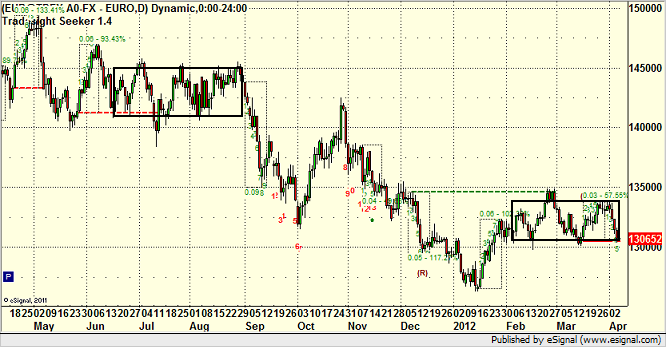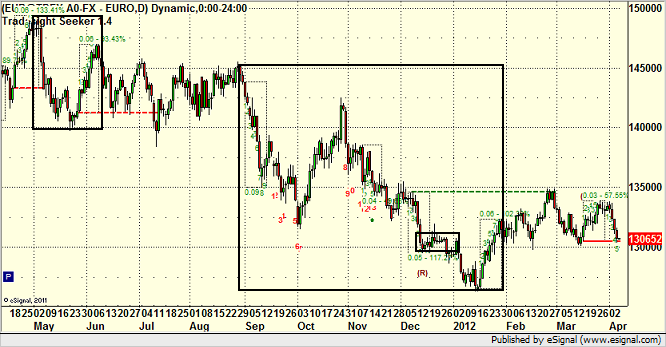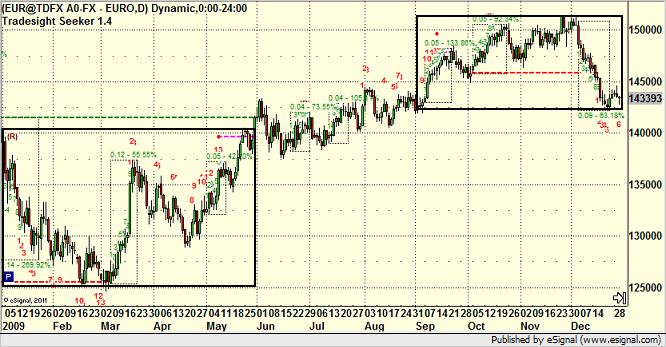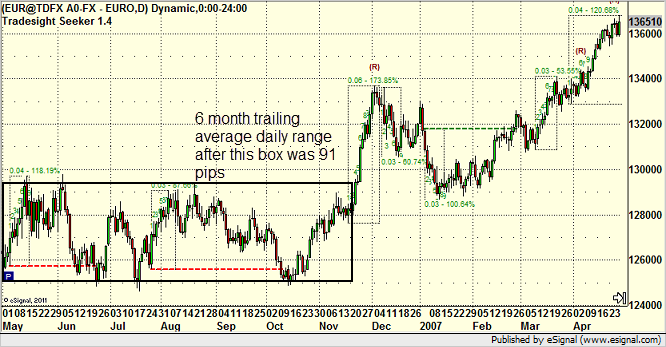I get a lot of questions about the bad ranges that we are experiencing in Forex right now and what that means and whether the Forex market is now dead forever because of the regulations that have come about in the last few years, some of which protect consumers, but others cut leverage and do things that some people believe affect the market negatively in terms of range.
Let me start by shooting down those theories.
1) All markets have dull periods and wild periods.
2) The Forex market moves based on global economic events and money flows. Just because the average retail daytrader can now only trade on 50:1 leverage instead of 100:1 doesn’t mean that the EURUSD can’t move. In fact, it will.
I hope by the end of this article, you’ll see that.
We track what we call “Average Daily Range” in the Forex pairs. Basically, we’re looking at the last six months of data on each pair. A “day’s range” is the high minus the low of the day. So let’s take the EURUSD. If the high is 1.3164 and the low is 1.3035 on a day (which it was Wednesday at 5 pm to Thursday at 5 pm EST), that’s 129 pips of range for the day. We then take that number for the last six month’s of trading days, add up the ranges, and divide by the number of trading days. This tell us the six month average.
It is VERY important to use 6 months and not less in these calculations. First of all, we use them as a trading support and resistance point when hit each day, and our research and backtesting showed that if you used less data, such as 2-3 months, the number swung more wildly and wasn’t used by the market. Anything over 6 months seems to have diminishing returns in terms of practical use.
So at this moment, the EURUSD 6 month ADR is 139 pips. That’s down from 168 pips, which was the 6 month trailing ADR at the end of 2011, just a mere three months ago. What does that mean in practical application? It means that in those three months, we saw a lot of days well under 139 pips that have brought the number down.
We make way more money when the market moves under our system, so lower ranges generally mean a few things:
1) Higher chance of stopping out of a trade
2) Less chance that even if a trade is profitable, it goes far or turns into a big winner
So, what’s the net importance? Periods of bad ranges mean lesser results from our trading. We’re going to make the most money when the ranges are good.
Now that we understand that dynamic, obviously it becomes important to know whether the Forex market is truly seeing worse ranges forever and is in a permanent decline or not. Even though the movement of the market is not about the leverage factor or how much retail money goes into daytrading, that seems to be a discussion among daytraders (who seem to give themselves too much credit for being the primary factor of market movement).
So let’s look at this graphically and see if we should be concerned.
Here are the last 12 months in the EURUSD, and I choose this because it is the most commonly traded pair:

I’ve boxed in two periods of a couple of months or so where the movement was limited, and thus the average daily ranges in there were smaller, bringing down the averages. Now, let me point out that even at the end of that first box, which is around September 1, 2011, the 6-month average range on the EURUSD was still 155 pips. So basically, even though there are 2-3 months of fairly flat activity there, the average for the first half or so of 2011 was 155, which is still 16 pips better than the current 139, and believe me, 16 pips off of a SIX MONTH average is a big deal. But, as I’ve already said, even after that cycle, we were back up to 168 pips on the average by the end of 2011.
2-3 months at a time of narrow ranges happens in Forex. It usually happens at least once a year. Also, a common time is July/August when the world is on summer break, especially out of Europe. Big decisions aren’t being made. Note that that first box in the chart above ended at the end of August, and remember that as we start going backward in time in a few paragraphs.
Now, let’s look at the same chart (last 12 months on the EURUSD) with boxes drawn around periods of good movement, which also raises average ranges by definition (it would be rare for the market to move over the course of a month in one direction fairly well, but for the range of each day to get worse in the course of that move):

What do we see here? I would say last May and into June had good range, and September through the end of January in general did, although I put a secondary box around three flat weeks, which was the end of year Holidays (also common, but you’ll see soon, not always the case).
If you go back and look at our results, we had some killer months in there. But those summer months were awful, and the current environment is even worse based on the ADR being 139 pips. And while it doesn’t correlate exactly, note that the EURUSD is exactly here at the start of April where it was at the start of October, six months ago.
Next, let’s start going back in time year by year, showing the full calendar year, starting with 2010, with boxes drawn around the periods where trading was good and ranges were good. That means that the areas between the boxes were dull. Here’s 2010:

What we see here is that mid-February through mid-April was boring, most of August was boring (on average, it’s the slowest month of the year), and December was slow, especially the back half (nothing unusual). So I would call 2010 a good year that saw less slow periods, and certainly nothing extended for more than about 6-8 weeks. The EURUSD cover 2500 pips that year.
2009:

2500 pips from high to low again, most of it in one direction. Three solid months (12 weeks) of doldrums in the summer. End of the year wasn’t bad. The funny thing here is that even with the movement, since July and August were so slow and the rest of the back half of the year wasn’t too wild, the ADR on the EURUSD at the end of the year was 132 pips…LOWER than it is right now!
By the way, you can log into our site and go to Forex Levels and go back to any date you want and see what the 6-month trailing ADR was at that time.
2008:

A great trading year. Some slowness in November for 4 weeks, and yet, still, we had a bad period from April through mid-July (strangely, the rest of July and August were great, so never STOP trading just because you hit August). The main point, though is that we saw a full 3 months of bad activity in 2008 also. I’m going to surprise you with the EURUSD ADR at the end of 2008 in a few paragraphs.
2007:

Another great trading year. Nothing to complain about except that period from mid-April to mid-June. This is really a dream year for traders. Trust me, there were no points where people were whining about the ranges being bad.
But here’s where the real point comes in. 2006:

While the back end of the year (starting the weekend of Thanksgiving if you were here and remember) and into 2007 were great, the prior 6-7 MONTHS were awful. The bulk of trading for that whole period was almost in a 200 pip range. I like days that hit that in a single session!
Trust me, everyone back then was proclaiming the death of Forex, which had really only come into the public eye about 4-5 years prior. People were saying “Everyone is trading Forex now, so the market can’t move” and “Now they are going to regulate it and ruin it.” Stuff like that. I had started trading Forex in 2005, but then again, I have been trading markets since 1989, so slow periods, I know, are part of the game, and we said that here at Tradesight at the time. Note the comment above the box on that 2006 chart. The ADR on the EURUSD on Thanksgiving Day 2006 was 91 pips! Today, we’re still at 139. And between here and there, scroll up and look back through all of those years and see all of the movement.
And then here’s the real doozy. What was the EURUSD ADR on December 31, 2008? 227 PIPS. That’s not a typo. Why? A little thing called the banking collapse of 2008. The markets went crazy…all markets.
So remember, in late 2006, everyone was proclaiming the death of Forex trading. Look at how 2007 went and 2008, and think about the change in ranges from that dull six month period in 2006 to the peak at the end of 2008 (227 pips of ADR is almost not tradeable from the other perspective…too much fast movement equals too much risk).
The driving factor of Forex isn’t regulation of the retail trading houses or lower leverage for the retail trader. It’s global economic forces, and believe me, maybe right this moment, with interest rates near zero globally and the problems we are still experiencing here from the real estate bust and banking collapse and the issues of debt in Europe…it’s a little bit frozen. But those are the reasons, and at some point, one way or another, something’s going to break. Could be a collapse of a country or someone starting to grow. Either one will get things moving.
Having said all of that, that’s why we trade stocks and futures here as well. They have trading just great even as Forex has gotten a little slow the last few months. But I don’t expect to go all the way through 2012 without some better periods for Forex too.
Have a great weekend.
